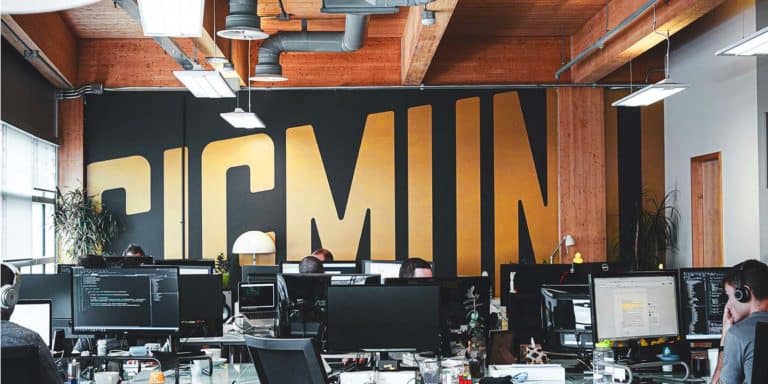How to become an Art Director in 10 steps

Some people find the path to becoming an art director a bit confusing, and it’s normal, because there are several options that can lead you to a job in art direction. In my case, I worked as an advertising art director after studying Advertising, but many of my peers came from studying or working in other fields, such as Graphic Design or Fine Arts.
To become an art director, it is advisable to study Design, Fine Arts or Communication, and then specialize in art direction. After acquiring the necessary experience and knowledge, build a solid portfolio, make yourself known professionally and then apply for a job in an agency or organization.
But let’s go point by point, because the devil is in the details, and how you execute each of these steps can make the difference between how easy or complicated your path to becoming a professional art director will be.
1. Know and understand the art director position.
It is important that as an aspiring art director you know and understand the communications market in general, because that is where most of the job opportunities for art directors are. By the way, the U.S. Bureau of Labor Statistics forecasts a 4% growth in demand for art directors between 2021 and 2031.
Find out who are the most renowned art direction professionals, which agencies or companies stand out in this regard, which are the communication or advertising campaigns and whose art direction is most valued or recognized by professionals in the sector?
At the same time, it is indispensable that you know the particularities of the role of the art director within an agency or corporation. This way, you can better understand what you need to learn and better prepare yourself for the responsibilities and functions that you will perform.
2. Study art direction
Art directors usually start by studying a degree in Fine Arts, Graphic Design or a field related to Communication, such as Advertising. They then specialize in art direction and are often trained in the principles of the other subjects through courses or master’s degrees.
This is because understanding and knowing how to put into practice the principles of Communication, Art and Graphic Design is the basis of art direction. In addition, since as an art director you will be collaborating with diverse professionals such as brand managers, creative directors, designers, illustrators, photographers and videographers, you must be able to communicate on their terms with precision.
Once you understand and master these fields, their concepts and principles, you will find it easier to come up with creative concepts, critically evaluate them and translate them into effective images.
In conclusion, there is no single path to becoming an art director, and you will always need to know a little bit of all the subjects I have mentioned. But don’t worry, because these subjects have many aspects in common and, consequently, it comes quite naturally to learn them.
Do you really need a degree or can you learn with online courses?
Your experience and learning path depends a lot on who your teachers are, your budget, your availability, and your ability. However, it is difficult to become an expert in Fine Arts, Graphic Design or Communication without teachers or tutors to guide you and help you develop your professional judgment.
That said, once you are an expert in one of these subjects and have solid criteria, you can complement the rest of your art director training with online Art Direction courses, workshops, books, etc.
3. Get the right tools and equipment
An art director is responsible for the overall look and feel of a particular brand, product, ad campaign or advertisement. Therefore, he or she must have the right tools and design team to create, edit, manage and share the images for those projects.
Some of the most important tools an art director needs today are a computer, a graphics tablet, a good quality monitor and software for image creation and processing. However, simple tools such as pencils, markers and paper, which are used especially during the ideation process, should not be forgotten either.
A good computer
An art director has to constantly create, edit and manage his or her proposals, as well as receive images or videos from designers, illustrators, production companies or other departments in the same organization where he or she works.
In-house art directors often work with iMacs, because they combine good performance for working with images and video, with a large, high-quality display at a reasonable price. The iMac is also an excellent choice as a home computer, although I prefer to use a laptop like the MacBook Pro. It gives me the performance I need and allows me to work from anywhere, not just my desktop.
A good external monitor
As an art director, you will be working with a lot of images and will sometimes have to review layouts, photo retouching and final artwork. Therefore, it is essential to work with a monitor that is large, has a high resolution (≥4K) and is very faithful in color reproduction.
Mac monitors are very good, but if you have decided on a laptop, you will need a large external monitor (≥24″) that allows you to work comfortably. I recommend you take a look at our selection of the best monitors for graphic designers. However, if your budget is very tight, I have also compiled and analyzed the best budget monitors on the market.
A graphics tablet
When you master the use of a graphics tablet, it allows you to work faster and more agile than a mouse, increasing your productivity. In addition, many of today’s graphics tablets offer a high level of precision, allowing you to create sketches and designs directly on the screen without having to go through, in many cases, a previous sketch on paper.
Check out our guide to the best graphics tablets to find the one that best suits your needs and your budget.
Design and image or video editing software
As an art director, you are going to have to manage and work with a lot of design and photography files, so you will need to learn and use the main design and photography programs. Adobe Photoshop and Adobe Illustrator are the most commonly used programs and, without a doubt, every art director should be proficient in them.
Then, depending on what type of art direction you specialize in, you may also need to learn to use other programs such as Adobe Lightroom, Adobe XD, Figma, Sketch or video editing software such as Adobe Premiere, Adobe After Effects, Final Cut or DaVinci Resolve.
The Adobe Creative Cloud collection of apps includes most of the programs I mentioned above and, although there are other app collections, such as those from Affinity or Corel, they don’t include as much variety of tools as Adobe, so I don’t recommend them for art direction.
4. Get hands-on experience
In addition to academic education, many employers look for art directors with practical experience, so internships and apprenticeships can help you build a portfolio that will help you demonstrate your expertise.
Small freelance jobs are also a great way to gain real-world experience and develop skills and work habits that will serve you well as you move more quickly through your career as an art director.
One way to gain experience is to offer your services to local companies or organizations. The other way is to create a profile on platforms like Fiverr, 99designs or UpWork, which connect companies with freelancers. In any case, your goal at this point should be to learn, not so much to make money. What matters is that you can put your skills into practice in the real world and see how your work is received by the public.
Working as a freelancer will also give you the opportunity to learn how to work and communicate better with different clients, colleagues and suppliers, while learning from them. If you do well, you will increasingly be entrusted with projects that require greater responsibility and, little by little, you will acquire more management and leadership skills.
5. Create an art direction portfolio
It is important that your potential employers know about your ability as an art director, even before they meet you in person, if you want to have a better chance of being granted a job interview. That’s why it is highly recommended that you create a portfolio that is representative of your potential.
When creating your portfolio, it is essential that you make a preliminary selection and show only your best work. Choose the most representative examples of your experience and be sure to explain your role in the creation of the piece.
In addition, it is recommended that you include brief descriptions of each project, so that potential employers can understand your creative process. This way, the employer can see the result of your work, but also understand how you got there.
Afterwards, we will see how to publish and publicize your portfolio, which will help you consolidate your personal brand as an art director and stand out from the competition. This will increase your chances of receiving job proposals and collaborations as an art director.
6. Never stop learning
Art direction is constantly evolving, so it is essential to be up to date in this subject, but also in related areas such as graphic design, illustration or photography, as they will allow you to discover new creative possibilities.
The effectiveness of art direction is based in part on innovation and, therefore, the trends, resources and techniques that were used a few years ago may not be as effective today.
Keep improving your knowledge and skills
You can keep learning in many ways: through online courses, attending in-person workshops, conferences, events, reading industry books and publications, etc. You can also join industry organizations that organize workshops, contests and events throughout the year. Some of the most prominent ones are:
- Art Directors Guild (ADG)
- Art Directors Club (ADC)
- British Design & Art Direction (D&AD)
- Art Directors Club of Europe (ADC*E)
Build your own professional network
Networking with other professionals in the industry is also a great way to learn more and keep up to date with the latest art direction news. By interacting with other art directors, you can also discover interesting aspects about their creative process, the tools they use and how they employ them.
Attend in-person events
The online world is great, but it’s also interesting to attend in-person events. Meeting people in the industry is key to finding mentors, learning about job openings and building relationships that could help you advance your career in the future.
7. Specialize in one area of art direction
Art direction can take you down many different paths that require very different knowledge and skills. So the sooner you figure out what type of art director you want to be, the sooner you can focus all your efforts on becoming an expert in a specific field.
The most popular types of art director are:
- Digital art director
- Art director for video games
- Art director for television
- Film Art Director
- Advertising Art Director
- Fashion Art Director
- Brand Art Director
8. Publicize your work
It is essential that you publicize your work as an art director to get job opportunities and collaborations. Also, by publicizing your work, you can sometimes receive feedback from the public that can help you improve.
Publish your portfolio online
There are two ways you can publish your portfolio online. One is to publish it on your own website and the other is to publish it on a specialized portfolio platform like Behance.
Personally, I recommend Behance for starters, as it allows you to get your portfolio online faster. Also, employers looking for professionals with your skills and abilities on this platform will be able to find you more easily.
Publish your work on Social Networks
Another way to publicize your work, but not a substitute for posting your portfolio online, is to post your work on image-centric social networks, such as Instagram, Pinterest or even Vero. It can also work for you to post on Facebook or Twitter if you have an existing audience for whom your work may be relevant.
Participate in advertising or design contests
Another good way to make your work known is to submit it to contests that have Art Direction categories. You can find local, national and international contests on the web where you can enter for free or very cheaply. You can also take a look at the Art Directors Guild, the Art Directors Club, the British Design & Art Direction or the Art Directors Club of Europe.
By entering and competing, you will be able to assess how your work compares to that of other entrants, and learn what the competition judges and the public value, if comments are allowed.
In addition, competitions often provide participants with increased media attention, especially those who win. On top of that, winners can sometimes walk away with financially attractive prizes.
9. Practice job interviews
Preparing for and practicing art director job interviews will help you relax when it’s time to sit down in front of an interviewer. It is important to practice both possible interview questions and how you will present your work. This way, you will arrive at the interview more relaxed and the interviewer will perceive that you have done your homework before presenting yourself, as is expected of a professional.
Be prepared for possible job-related questions.
In any art director job interview, the interviewer will want to know about your professional experience and your knowledge of the position and the company. Their goal is to know if your experience matches the needs of the position, if you understand what it entails and if you are truly motivated.
It is therefore important that you prepare the way you describe your professional experience, but also that you do some research about the position and the company. Find out what the company’s values, mission, vision, products or services, competition, etc. are.
Interviewers appreciate it when a candidate has taken the trouble to learn about the company, because it shows interest.
Plan how you will present your portfolio
Your portfolio tells them about your work, but not about who you are or how you work, so interviewers want you to explain your work. Among other things, they want to get a sense of your personality, your attitude, how you reason, how you explain your creative process, what your priorities are …..
This will come naturally as you gain more experience, but in the beginning it is best to practice explaining your work. The goal is to get clear and concise explanations, as interviewers often don’t have a lot of time.
A good way to improve your job presentation is to write an outline of the key points of each job and try to develop them out loud, over and over again, until you arrive at a brief but complete explanation.
Keep it professional
In the creative world we are given some license when it comes to dressing and speaking at interviews, however, don’t confuse this with neglecting your professionalism. Be on time for the interview, greet the interviewer politely and make sure to keep the conversation calm and professional.
When you are finished, say a cordial goodbye to your interviewer and thank them for their time. It is always a good idea to send a thank you note the day after the interview to reiterate your interest in the position and, again, thank them for their time.
10. Get a job as an art director
Once you have some experience and a solid portfolio, it’s time to start looking for and applying for art director jobs. You can start by looking for job openings on job boards or specialized websites like LinkedIn, Indeed or Monster.com.
In my case, LinkedIn has always worked very well for me, and if you sign up for LinkedIn Premium you receive information on who views your profile, how your profile ranks against other applicants. In addition, the Premium subscription gives you access to LinkedIn Learning courses, so you can improve your skills even more.
If you want to work for a particular company or advertising agency, the best thing to do is to spend some time getting to know them in depth before you apply. This will help you to adapt your portfolio to the style and needs of the company or its clients, which will increase your chances of being hired.
Now you just have to be patient. There are many companies and many job opportunities for talented art directors.






